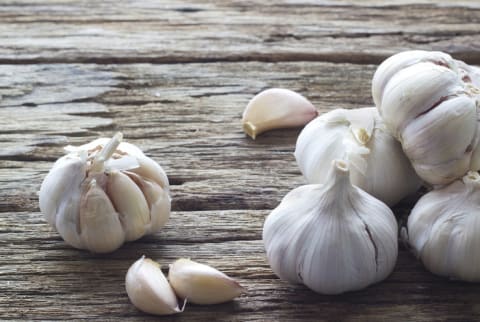Advertisement
Why You Should Be Eating More Garlic


Garlic is one of the most amazing health foods I know. It’s rich in inulin, a plant fiber that both nourishes the microbiome and helps heal the gut. (It also has terrific weight loss properties.) It’s also loaded with allicin and diallyl sulfides, which support your heart and cardiovascular system in remarkable ways.
Among other benefits, garlic is good for:
- reducing blood pressure
- lowering cholesterol, both total and LDL (the “bad” cholesterol)
- lowering oxidative stress
- reducing the risk of coronary artery disease
- decreasing the “stickiness” of blood platelets, which helps prevent stroke and other cardiovascular dangers
- reducing atherosclerotic plaque, also protective against stroke and cardiovascular disease
Garlic responds to our cardiovascular problems so completely that I actually think of it as a wise vegetable that co-evolved with us humans almost in lockstep: What we need, it has!
Garlic also increases our body’s supply of glutathione, a natural detoxifier, and aid in colon health. Garlic is also good for combating an overgrowth of unfriendly bacteria. With all of these protective effects, no wonder legend has it that garlic also repels vampires!
Tips for Buying and Preparing Garlic
To me, garlic is the king of vegetables: It makes almost every recipe better, and I can’t imagine cooking without it. If you’re used to using garlic powder, I can’t wait for you to switch to the real thing, which has so many more health and flavor benefits that it really is worth the tiny amount of extra trouble involved.
When shopping for fresh garlic, look for a moderate-sized white bulb covered in a natural white papery skin. The skin covers many little cloves of garlic, which you will pull away, peel, and chop up.
Look for firm bulbs, neither mushy nor dried out.
Please avoid the jars of pre-chopped garlic — it just doesn’t taste the same.
To cook garlic, my one overall note: You never want to brown the garlic, only to warm it up enough to flavor the oil. Cook garlic carefully on low heat, and you will be rewarded with a delicious, subtle taste that wakes up all the other ingredients’ flavors.
Rich Vegetable Soup
The French call this type of soup “Soupe a la pistou”: a fragrant vegetable soup garnished with pistou, a savory infusion of chopped fresh basil, garlic, and tomato. It’s a wonderful way to load up on vegetables, which will leave you feeling full and satisfied without that overstuffed, bloated feeling you can sometimes get from too much meat or starch.
You’re also loading up on microbiome superfoods — leeks and carrots in the soup and garlic and tomato in the pistou. If you’re looking for some extra protein, add the chicken pieces. The pistou makes enough for a few servings and will keep well in the fridge or freezer.
Ingredients
- 2 tablespoons olive oil
- 1 leek, washed and sliced, green tops discarded
- ¼ bunch kale, washed, ribs removed, rough chopped
- 1 tablespoon chopped garlic
- 1 small turnip, peeled and chopped
- 1 celery stalk, chopped
- 1 carrot, peeled and chopped
- 1 parsnip, peeled and sliced
- 3 cups chicken stock
- 1 zucchini, diced
- ¼ pound mushrooms, stemmed, cleaned, and sliced
- ¼ cup cooked chicken pieces (optional)
Pistou Ingredients
- 2 tablespoons minced garlic
- 4 cups basil leaves (about 2 ounces)
- ⅓ cup rough chopped tomatoes or 3 tablespoons organic tomato paste
- ½ teaspoon salt
- ½ teaspoon pepper
- ⅓ cup olive oil
- Salt and pepper
Preparation
1. In a large, heavy-bottomed pot, gently heat olive oil over medium-low heat, add leek and kale, and cook 5 minutes until golden. Add garlic, and cook for 2 minutes.
2. Add the turnip, celery, carrot, and parsnip, and cook for 5 minutes. Add the chicken stock, and simmer for 45 minutes or until vegetables are tender.
3. Add the zucchini, mushrooms, and optional chicken, and simmer for 10 minutes until tender.
4. Make the pistou: While the soup is cooking, put the garlic, basil, tomatoes, and salt and pepper in a food processor or blender, and puree until almost smooth. Gradually add the oil. Refrigerate until ready to serve.
5. To serve, stir 3 tablespoons of the pistou into the hot soup. Add salt, pepper, and more pistou to taste.
This was excerpted from the book The Microbiome Diet by Raphael Kellman, MD. Excerpted by arrangement with Da Capo Lifelong, a member of the Perseus Books Group. Copyright © 2014.